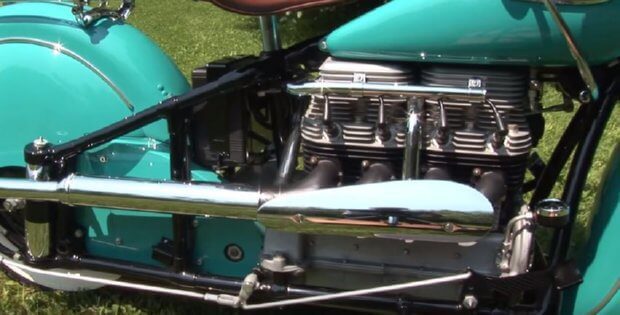Described as the Cadillac on two wheels because the Indian Four was such a smooth bike to ride, helped no doubt by its 5 main bearing crankshaft and a heavy 20lb flywheel.
The 1940 model in the top video has been beautifully restored and an absolute credit to the owner who did the entire restoration himself, and at the time this video was made the Indian had since covered over 5000 miles.
The bike is not without its quirks though, for instance when the bike was in gear but not moving the clutch pedal had to be physically held down. If the rider overbalanced to the left he needed some quick hand work to get the bike back into neutral before taking his foot off the clutch. Otherwise it became a bad case of OOPS!.
The throttle was also on the left side, but looking at other reviews it seems some owners converted the throttle to the right handlebar.
But this would have created another problem of adjusting engine revs while changing gear as the hand gear shift was also on the right side. Could be this is where the term “crossover” originated?
The inline four-cylinder 77 cub in engine was originally built by Ace Motorcycles, who Indian bought out in 1927 and used the engine in the Four from 1928 to 1943.
Originally the Ace motor had a 3 bearing crankshaft but in 1929 Indian redesigned the crankcase and crankshaft to a 5 main bearing.
Up until 1936 it was overhead inlet with side exhaust valve, but for the years 1936 -37 Indian reversed this with overhead exhaust and side inlet valve, which gave the engine more power but it ran a lot hotter much to the discomfort of the rider.
This also meant the exhaust valve rocker clearance needed frequent adjustment, and so its sales declined.
It was a very expensive bike and from 1938 to 1943 less than a thousand were sold each year.
Twin carburetors were fitted but only for the year 1937.
The front suspension was a leaf spring connected to trailing link forks which are reported as giving a comfortable ride, especially from 1940 on when the rigid rear wheel was upgraded to plunger type suspension.
A much sought after bike today well worth restoring.
The video below this one is the last Indian Four model made before production stopped, you can see and hear it going.
There are close up shots in this video that really show the beauty of this bike.

